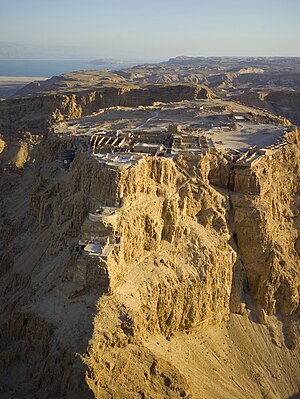
Back حصار مسعدة Arabic Belagerung von Masada German Πτώση της Μασάντα Greek Masada piiramine ET محاصره مسعده FA Masadan piiritys Finnish Massada#Histoire French Pengepungan Masada ID Assedio di Masada Italian Oblężenie Masady Polish
| Siege of Masada | |||||||
|---|---|---|---|---|---|---|---|
| Part of the First Jewish–Roman War | |||||||
 Masada National Park | |||||||
| |||||||
| Belligerents | |||||||
| Jewish Sicarii | Roman Empire | ||||||
| Commanders and leaders | |||||||
| Eleazar ben Ya'ir † | Lucius Flavius Silva | ||||||
| Strength | |||||||
| 967, including non-combatants |
Legio X Fretensis 4,800 Auxiliaries and slaves 4,000–10,000 | ||||||
| Casualties and losses | |||||||
| 960 dead, 7 captured (2 women, 5 children), according to Josephus | Unknown | ||||||
The siege of Masada was one of the final events in the First Jewish–Roman War, occurring from 72 to 73 CE on and around a hilltop in present-day Israel.
The siege is known to history via a single source, Flavius Josephus,[3] a Jewish rebel leader captured by the Romans, in whose service he became a historian. According to Josephus the long siege by the troops of the Roman Empire led to the mass suicide of the Sicarii rebels and resident Jewish families of the Masada fortress.
In modern times, the story of the siege was revived as the Masada myth, a selectively constructed narrative based on Josephus's account. The mythical narrative became a national symbol in the early years of Israel's nationhood.[4]
- ^ Campbell, Duncan B. (1988). "Dating the Siege of Masada". Zeitschrift für Papyrologie und Epigraphik. 73 (1988): 156–158. JSTOR 20186870.
- ^ Cotton, Hannah M. (1989). "The Date of the Fall of Masada: The Evidence of the Masada Papyri". Zeitschrift für Papyrologie und Epigraphik. 78 (1989): 157–162. JSTOR 20187128.
- ^ The Myth of Masada: How Reliable Was Josephus, Anyway?: "The only source we have for the story of Masada, and numerous other reported events from the time, is the Jewish historian Flavius Josephus, author of the book The Jewish War."
- ^ Green 1997, pp. 414–416.